A kit lens is a "starter" lens which can be sold with an interchangeable-lens camera such as a mirrorless camera or DSLR. It is generally an inexpensive lens priced at the lowest end of the manufacturer's range so as to not add much to a camera kit's price. The kit consists of the camera body, the lens, and various accessories usually necessary to get started. A kit lens can be sold by itself outside of a kit, particularly the ones that are moderately expensive; for instance a kit lens included in a prosumer camera kit is often marketed as an upgrade lens for a consumer camera. In addition, retailers often have promotions of standalone low-end camera bodies without the lens, or a package that bundles a body with one or two more expensive lenses.

The Nikon F-mount is a type of interchangeable lens mount developed by Nikon for its 35mm format single-lens reflex cameras. The F-mount was first introduced on the Nikon F camera in 1959, and features a three-lug bayonet mount with a 44 mm throat and a flange to focal plane distance of 46.5 mm. The company continues, with the 2020 D6 model, to use variations of the same lens mount specification for its film and digital SLR cameras.

The Nikon DX format is an alternative name used by Nikon corporation for APS-C image sensor format being approximately 24x16 mm. Its dimensions are about 2⁄3 those of the 35mm format. The format was created by Nikon for its digital SLR cameras, many of which are equipped with DX-sized sensors. DX format is very similar in size to sensors from Pentax, Sony and other camera manufacturers. All are referred to as APS-C, including the Canon cameras with a slightly smaller sensor.

The Nikon D40 is a 6.1-megapixel DX format DSLR Nikon F-mount camera announced by Nikon on November 16, 2006. It replaces the D50 as Nikon's entry level DSLR. It features a 2.5-inch 230,000-dot resolution LCD monitor, CCD sensor with ISO 200-1600 and 3D Color Matrix Metering.
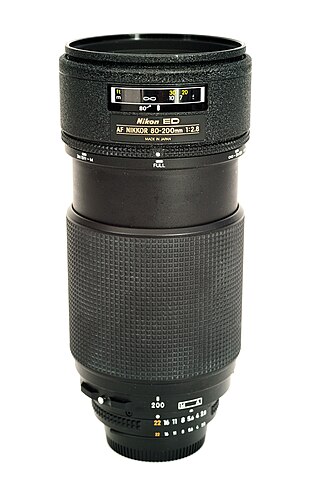
Nikon F 80-200mm lens refers to several generations of single-lens reflex telephoto zoom lenses for made by Japanese camera manufacturer Nikon.
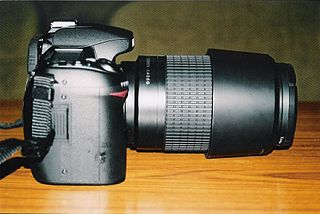
The 70-300mm lens is a telephoto zoom lens made by Nikon. The lens has an F-mount to work with all the SLRs line of cameras, although the more recent AF-P lenses will not focus on film SLRs or older DSLRs.

The 55-200mm AF-S lens is a medium telephoto zoom lens manufactured by Nikon for use on Nikon DX format digital SLR cameras. It comes in three variants:
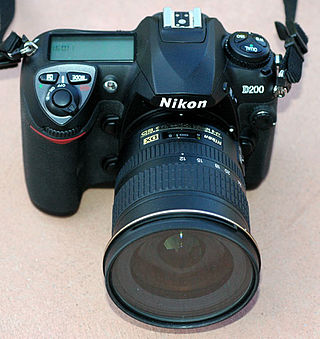
The AF-S DX Zoom-Nikkor 12-24mm f/4G is a lens manufactured by Nikon for use on Nikon DX format digital SLR cameras. It provides an angle of view on a DX format camera similar to that of an 18-35mm lens on a 135 film format camera.

The 18-55mm f/3.5-5.6G AF-S Zoom-Nikkor lens is a midrange zoom lens manufactured by Nikon for use on Nikon DX format digital SLR cameras. Often included as a kit lens on entry-level DSLRs, it also can be purchased separately from the camera body. Nikon first introduced the lens in 2005 and has provided five subsequent updates. The last two iterations have AF-P type autofocusing with a stepper motor, while all others use an SWM autofocus motor. Following are the six variants as of 2024:

The Nikon AF-S DX Zoom-Nikkor 16-85mm f/3.5-5.6G IF-ED VR is a wide to medium telephoto zoom lens produced by Nikon Corporation for its Nikon DX format digital SLR cameras.

The Nikon F-mount teleconverters are a group of magnifying lenses mounted between the lens and camera bodies using the Nikon F-mount. Currently, 1.4x, 1.7x and 2x converters are available separately; a fourth, the 1.25x, is available only with Nikon's newest 800mm supertelephoto lens.

The AF-S DX Nikkor 18-105mm f/3.5-5.6G ED VR is a superzoom lens manufactured by Nikon, introduced in August 2008 for use on Nikon DX format digital SLR cameras. This lens is sold as a kit lens for the Nikon D90, Nikon D7000, Nikon D5100, Nikon D5200 and Nikon D3200 cameras, but it also can be purchased separately from the camera body.

The Nikon 1 series is a discontinued camera line from Nikon, originally announced on 21 September 2011. The cameras utilized Nikon 1-mount lenses, and featured 1" CX format sensors.
The 18-300mm f/3.5-6.3G lens is a telephoto superzoom lens manufactured by Nikon for its line of DX DSLR cameras.
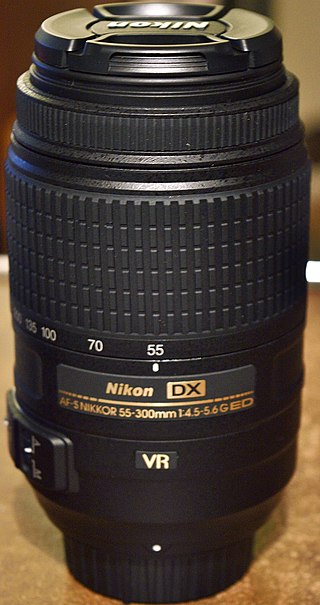
The 55-300mm f/4.5-5.6G AF-S lens is a telephoto superzoom lens manufactured by Nikon for its line of DX DSLR cameras.
The 18-300mm f/3.5-5.6G ED VR is a telephoto superzoom lens manufactured by Nikon for its line of DX DSLR cameras.
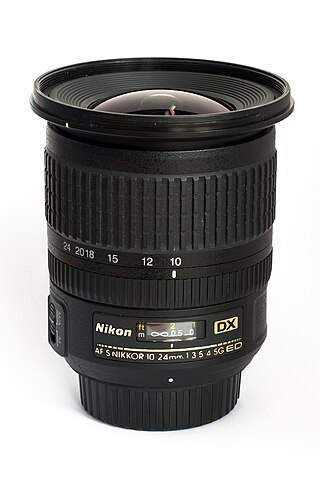
The AF-S DX Zoom-Nikkor 10-24mm f/3.5-4.5G ED is a lens manufactured by Nikon for use on Nikon DX format digital SLR cameras. It provides an angle of view on a DX format camera similar to that of a 15-35mm lens on a 135 film format camera.

Nikon Z-mount is an interchangeable lens mount developed by Nikon for its mirrorless digital cameras. In late 2018, Nikon released two cameras that use this mount, the full-frame Nikon Z7 and Nikon Z6. In late 2019 Nikon announced their first Z-mount camera with an APS-C sensor, the Nikon Z50. In July 2020 the entry-level full-frame Z5 was introduced. In October 2020, Nikon announced the Nikon Z6II and Nikon Z7II, which succeed the Z6 and Z7, respectively. The APS-C lineup was expanded in July 2021, with the introduction of the retro styled Nikon Zfc, and in October 2021, Nikon unveiled the Nikon Z9, which effectively succeeds the brand's flagship D6 DSLR. The APS-C lineup was further expanded with the Nikon Z30, announced at the end of June 2022. The Nikon Z6III was announced in June 2024. In November 2024, Nikon announced the Z50II, the first APS-C camera to use the Expeed 7 processor introduced with the Z9.

Micro-Nikkor is a family of macro lenses produced by Nikon for their 35mm film and digital cameras. The first Micro-Nikkor lens was the 5cm f/3.5 lens introduced in 1956 for Nikon's S-mount rangefinder cameras. It was designed to produce microforms of texts written in Japanese using the Kanji alphabet, a task that, according to Nikon's corporate history, western microphotography systems were ill-equipped to handle, as Kanji text contains many more small details compared to Latin texts. The 5cm f/3.5 was later modified to have a slightly higher focal length of 55mm to accommodate the longer flange-focal distance of Nikon's SLR F-mount.


















